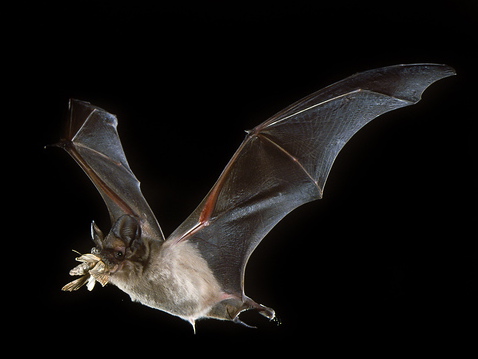Free-tailed Bat
(Tadarida Brasiliensis)
PHOTOS BY MERLIN TUTTLE
The fur is uniformly dark brown or dark grey. The tail extends beyond the tail membrane between hind feet. Long hairs on toes. Long narrow wings provide for fast flight.
Primary Prey: Forages mainly on moths. A farmer’s friend eating moths whose larva eats crops. Feed on migratory moths at very high altitude, up to 10,000 feet. Also eats flying ants, weevils, stink-bugs and ground beetles.
Predators: Predators include Red-tailed Hawk and other birds of prey, as well as cats and dogs which locate roosts and wait for emergence
Range: Migratory. Found from central North America to northern South America.
Status: Common
Threats: Besides the human disturbance and habitat destruction, or alteration of suitable caves, mines, bridges, and old buildings noted above, colonies once numbering in the millions have been dramatically reduces in size due to human disturbance and habitat destruction of caves as well as problems with pesticide poisoning and deliberate eradication attempts.
Behavior: Brazilian free-tailed bats often fly more than 50 km to reach foraging areas. Such flight is rapid, direct, and often involves gliding. Bats from one colony may cover areas as large as 400 km2 and move at speeds over 40 km/hour and at altitudes of 3,000 meters or more. Foraging occurs at high elevations and also at heights of 6 to 15 meters. This species is highly colonial with maternity colonies ranging in size from a few hundred to 20 million. The most commonly used natural roosts are caves and rock crevices on cliff faces. This species also roosts in abandoned mines and tunnels, highway bridges and large culverts, buildings, and bat houses.
Wingspan: 30-cm / 12 inches
Weight: 11g / .4 oz
Body Length: 86mm-114 mm / 3.4 – 4.3 inches
Offspring: 1 pup. Pup fly at 5weeks
Life Span: 15 years or more



